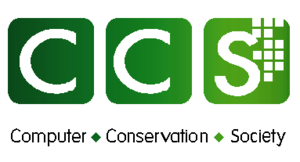
The Electronic Delay Storage Automatic Calculator (EDSAC) was an early British computer. Inspired by John von Neumann's seminal First Draft of a Report on the EDVAC, the machine was constructed by Maurice Wilkes and his team at the University of Cambridge Mathematical Laboratory in England. EDSAC was the second electronic digital stored-program computer to go into regular service.

The history of computing hardware covers the developments from early simple devices to aid calculation to modern day computers.

The LEO was a series of early computer systems created by J. Lyons and Co. The first in the series, the LEO I, was the first computer used for commercial business applications.
A stored-program computer is a computer that stores program instructions in electronically or optically accessible memory. This contrasts with systems that stored the program instructions with plugboards or similar mechanisms.

Sir Maurice Vincent Wilkes was an English computer scientist who designed and helped build the Electronic Delay Storage Automatic Calculator (EDSAC), one of the earliest stored program computers, and who invented microprogramming, a method for using stored-program logic to operate the control unit of a central processing unit's circuits. At the time of his death, Wilkes was an Emeritus Professor at the University of Cambridge.

The Manchester Baby, also called the Small-Scale Experimental Machine (SSEM), was the first electronic stored-program computer. It was built at the University of Manchester by Frederic C. Williams, Tom Kilburn, and Geoff Tootill, and ran its first program on 21 June 1948.

Thomas Harold Flowers MBE was an English engineer with the British General Post Office. During World War II, Flowers designed and built Colossus, the world's first programmable electronic computer, to help decipher encrypted German messages.

Tom Kilburn was an English mathematician and computer scientist. Over his 30-year career, he was involved in the development of five computers of great historical significance. With Freddie Williams he worked on the Williams–Kilburn tube and the world's first electronic stored-program computer, the Manchester Baby, while working at the University of Manchester. His work propelled Manchester and Britain into the forefront of the emerging field of computer science.

Pegasus was an early British vacuum-tube (valve) computer built by Ferranti, Ltd that pioneered design features to make life easier for both engineers and programmers. Originally it was named the Ferranti Package Computer as its hardware design followed that of the Elliott 401 with modular plug-in packages. Much of the development was the product of three men: W. S. (Bill) Elliott (hardware); Christopher Strachey (software) and Bernard Swann. It was Ferranti's most popular valve computer with 38 being sold. The first Pegasus was delivered in 1956 and the last was delivered in 1959. Ferranti received funding for the development from the National Research Development Corporation (NRDC).
Andrew James Herbert, OBE, FREng is a British computer scientist, formerly Chairman of Microsoft Research, for the Europe, Middle East and Africa region.

In electronics, a Dekatron is a gas-filled decade counting tube. Dekatrons were used in computers, calculators, and other counting-related products during the 1950s and 1960s. "Dekatron" was the brand name used by Ericsson Telephones Limited (ETL), of Beeston, Nottingham and has since become a generic trademark. The device was invented by John Reginald Acton, with the patent assigned to Ericsson.

The National Museum of Computing is a museum in the United Kingdom dedicated to collecting and restoring historic computer systems. The museum is based in rented premises at Bletchley Park in Milton Keynes, Buckinghamshire and opened in 2007. The building — Block H — was the first purpose-built computer centre in the world, hosting six Colossus computers by the end of World War II.

Anthony Edgar "Tony" Sale, FBCS was a British electronic engineer, computer programmer, computer hardware engineer, and historian of computing. He led the construction of a fully functional Mark 2 Colossus computer between 1993 and 2008. The rebuild is exhibited at The National Museum of Computing at Bletchley Park in England.
Geoffrey ("Geoff") Colin Tootill was an electronic engineer and computer scientist who worked in the Electrical Engineering Department at the University of Manchester with Freddie Williams and Tom Kilburn developing the Manchester Baby, "the world's first wholly electronic stored-program computer".

The Harwell computer, or Harwell Dekatron computer, later known as the Wolverhampton Instrument for Teaching Computing from Harwell (WITCH), is an early British computer of the 1950s based on valves and relays. From 2009 to 2012, it was restored at the National Museum of Computing. In 2013, for the second time, the Guinness Book of World Records recognised it as the world's oldest working digital computer, following its restoration. It previously held the title for several years until it was decommissioned in 1973. The museum uses the computer's visual, dekatron-based memory to teach schoolchildren about computers.

Doron Swade MBE, born 1944, is a museum curator and author, specialising in the history of computing. He is especially known for his work on the computer pioneer Charles Babbage and his Difference Engine.
John Harper is a retired computer engineer. He led a Computer Conservation Society/Bletchley Park team that rebuilt a working World War II electromechanical Bombe decryption device.
Edmund Harry Cooke-Yarborough was the lead designer of the Harwell Dekatron, one of the world's early electronic computers and also a pioneer of radar.

The Turing Guide, written by Jack Copeland, Jonathan Bowen, Mark Sprevak, Robin Wilson, and others and published in 2017, is a book about the work and life of the British mathematician, philosopher, and early computer scientist, Alan Turing (1912–1954).














